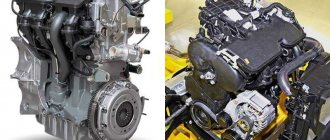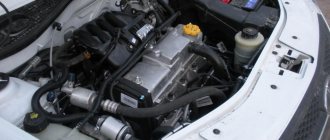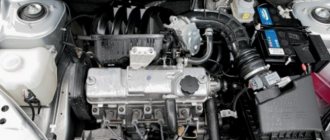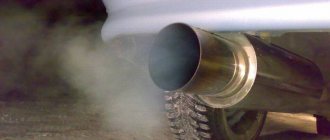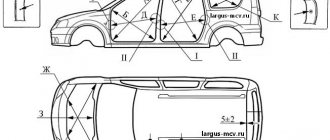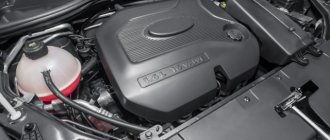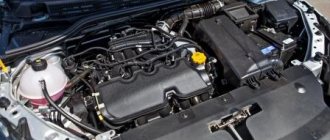Depending on the year of manufacture, the Largus may be equipped with a Renault or VAZ engine. Currently, only domestic engines are installed on this car. Let's take a closer look at the technical characteristics of Lada Largus engines, as well as the features of their assembly.
- Renault-Nissan K7M
(8 valves) with a volume of 1.6 liters is capable of developing a power of 84 hp. This motor is installed on the “standard” and “norm” configurations. - Renault-Nissan K4M
(16 valves) is slightly more powerful, also 1.6 liters, but has a power of 105 hp. or 77 kW. The motor is provided for the “luxury” configuration. - VAZ 11189
(1.6 liter, 87 hp, 8 valves) began to be installed instead of K7M in 2015. - VAZ 21129
(1.6 liter, 106 hp, 16 valves) began to be installed instead of Renault K4M in October 2021. - VAZ 11182
(1.6l., 90hp, 8kl) began to be installed on Largus FL from March 2021
Both are Renault Alliance engines. Since December 2015, AVTOVAZ began installing its 8-valve VAZ-11189 engine. You can get acquainted with its pros and cons from this review.
Both engines from Renault-Nissan are paired with a 5-speed manual transmission. At the moment, AVTOVAZ does not plan to equip the Lada Largus with an automatic transmission.
Lada Largus engines are distinguished by high elasticity, and the manual gearbox is distinguished by precise gear shifting. For dynamic acceleration and confident overtaking, the engine power is quite enough. Both Lada Largus engines comply with Euro 4 environmental requirements.
Depending on the vehicle configuration, there are several options for installing auxiliary equipment on the engine:
- car with non-power steering;
- car without power steering with air conditioning;
- vehicle with hydraulic power steering;
- car with hydraulic power steering and air conditioning.
Technical characteristics of Renault engines
| Options | Engine model | |
| RENAULT, K4M | RENAULT, K7M | |
| Injection type | Electronically controlled multipoint fuel injection | |
| Fuel type | Gasoline Premium-95 GOST 51105-97 | |
| Number and arrangement of cylinders | 4, in-line | |
| Number of valves | 16 | 8 |
| Cylinder operating order | 1-3-4-2 | |
| Direction of rotation of the crankshaft (camshaft drive side) | ||
| right | ||
| Cylinder diameter/piston stroke, mm | 79,5×80,5 | |
| Working volume, cm3 | 1598 | |
| Compression ratio | 9,8 | 9,5 |
| Toxicity standards | Euro 4 | |
| Power at 5500 rpm, kW (hp) | — | 62 (84) |
| Power at 5750 rpm, kW (hp) | 77 (105) | — |
| Maximum torque, N.m (at rpm) | 148 (3750) | 124 (3000) |
| Volume of oil poured into the engine lubrication system, including oil filter, l | 4,8 | 3,3 |
Description of the K7M engine (Renault Logan/Sandero/Largus)
In 2010, the K7M 800 engine appeared, which replaced the K7M 710. No design changes occurred, except that the engine was strangled, bringing it up to the Euro-4 environmental standard, while the power decreased from 86 hp to 83 hp. With.
The disadvantages of the engine remain the same:
- high fuel consumption.
- At idle the speed often fluctuates.
- Every 20-30 thousand km the valves need to be adjusted.
- no hydraulic compensators.
- If the belt breaks, the valve bends; it is recommended to change the belt every 60 thousand km.
- crankshaft oil seal leaking.
- the engine is noisy.
- there are vibrations during operation.
If you look at the engine from the positive side, it is worth noting its high reliability; according to the passport, the engine life is about 400 thousand km, but in practice it is a little more.
Description of the K4M engine (Renault Logan/Sandero/Largus)
It is a development of the K7M series, with a new cylinder head, already 16 valve. There are many differences: K4M is quieter, it is more economical, there are no vibrations and many other advantages.
Motor disadvantages:
- expensive spare parts.
- If the belt breaks, the valve bends; it is recommended to change the belt every 60 thousand km.
- there are failures in work.
- Low-quality fuel causes the revs to fluctuate.
- troit (most often the problem is in the ignition coil, injectors or spark plugs).
- Unstable operation and floating speed are usually caused by the crankshaft position sensor or ignition coil.
If you choose between K7M and K4M, then the choice should definitely remain with the more modern and practical K4M.
Whose engine is Lada Largus
Previously, engines for Lada Largus came assembled from the Renault plant in Spain, but recently engines of the K4M series (16 valves, 105 hp) began to be assembled at AVTOVAZ. According to the director of the Power Units project, Francois Goujon, the quality of engines assembled at AVTOVAZ corresponds to the world level.
The AVTOVAZ press service assures that a quality system is used in the production of new engines to ensure that products comply with the international standards of the alliance. In addition to personnel training, it includes control on the production line, during which each assembled engine is tested in different modes on a special stand. The technology also provides for a weekly check, when one of the motors is completely disassembled and the quality of its assembly is analyzed.
Content
- Who is the seven-seater cabin suitable for?
- Are there any differences in the configurations?
- What engines are on the Lada Largus?
- How does the Cross version differ from the regular one?
- What problems might you encounter?
- What to look for when choosing a Lada Largus
- Which Largus to choose
LADA Largus is one of the most affordable station wagons on the Russian market. On the secondary market it is sold on average for 461 thousand rubles.
The model went on sale in 2012 and has never been updated since then. You can choose from 5- or 7-seater body styles, a van or a Largus Cross raised by 25 mm.
Until 2021, Largus was sold with French engines, and after they were replaced by Russian engines of the same displacement. We'll look into this article about which Largus is better and which modification to choose on the used market.
About the domestic VAZ 11189 engine
In April 2021, AVTOVAZ began installing domestic VAZ 11189 engines on Largus. The advantages of this engine are described in one of the issues of “Okay Mechanics”.
| Some measurement results Autoreview | |||
| Options | Cars | ||
| Lada Largus (VAZ engine) | Lada Largus (Renault engine) | ||
| Maximum speed, km/h | 157,1/156,7* | 168,0/167,6 | |
| Acceleration time, s | 0—50 km/h | 4,3/4,8 | 3,9/4,4 |
| 0—100 km/h | 13,9/16,8 | 12,5/14,5 | |
| 0—150 km/h | 61,1/71,6 | 38,9/43,7 | |
| on the way 400 m | 19,3/20,2 | 18,4/19,4 | |
| on the way 1000 m | 36,1/37,8 | 34,1/36,0 | |
| 60-100 km/h (III) | 8,7/10,6 | 9,3/10,6 | |
| 60-100 km/h (IV) | 12,1/15,1 | 12,8/14,1 | |
| 80-120 km/h (V) | 19,3/24,0 | 22,1/23,4 | |
| * Partial load/full load | |||
| Engine characteristics | ||
| Options | VAZ-11189 | Renault K4M |
| Volume, cm3 | 1596 | 1598 |
| Number of valves | 8 | 16 |
| Maximum power, hp/kW/rpm | 87/64/5100 | 102/75/5750 |
| Maximum torque, Nm/rpm | 140/3800 | 145/3750 |
| Cylinder diameter/piston stroke, mm | 82,0/ 75,6 | 79,5/80,5 |
| Compression ratio | 10,3:1 | 9,8:1 |
| Injection type | distributed, electronically controlled | |
| Octane number of gasoline | at least 92 | not less than 95 |
Choosing the best Lada Largus engine
Depending on the year of manufacture, the Largus may be equipped with a Renault or VAZ engine. Currently, only domestic engines are installed on this car. Let's take a closer look at the technical characteristics of Lada Largus engines, as well as the features of their assembly.
- Renault-Nissan K7M
(8 valves) with a volume of 1.6 liters is capable of developing a power of 84 hp. This motor is installed on the “standard” and “norm” configurations. - Renault-Nissan K4M
(16 valves) is slightly more powerful, with 105 hp. or 77 kW. The motor is provided for the “luxury” configuration. - VAZ 11189
(8 valve engine) began to be installed instead of K7M in 2015. - VAZ 21129
(16 valves) began to be installed instead of Renault K4M in October 2017.
Both are Renault Alliance engines. Since December 2015, AvtoVAZ began installing its 8-valve VAZ-11189 engine.
Both engines from Renault-Nissan are paired with a 5-speed manual transmission. At the moment, AvtoVAZ does not plan to equip the Lada Largus with automatic transmission.
Lada Largus engines are distinguished by high elasticity, and the manual gearbox is distinguished by precise gear shifting. For dynamic acceleration and confident overtaking, the engine power is quite enough. Both Lada Largus engines comply with Euro 4 environmental requirements.
New VAZ 11182 engine
At the beginning of 2021, AVTOVAZ introduced a new 8-valve 1.6-liter engine (VAZ 11182 or AR16SEg2), which first appeared on the Lada Largus FL and will later appear on the Lada Granta FL.
AVTOVAZ writes that the new engine featured an updated connecting rod and piston group, a modernized crankshaft and a gas distribution mechanism. As a result, power is increased to 90 hp, and 80% of torque is available from 1000 rpm, which reduces fuel consumption and reduces shift frequency. In addition, the need to adjust valves before a mileage of 90,000 kilometers is eliminated. The engine is adapted to run on gasoline with an octane rating of 92. Read more about the design in this review. Technical characteristics and reviews about it are at the link.
Let us remind you that you can read about the VAZ 21129 engine here.
Key words: Lada Largus engine
+23
Share on social networks:
Found an error? Select it and press Ctrl+Enter..
Design features of engines
In relation to 11182, the modernization carried out turned out to be a double-edged sword. Yes, it made it possible to increase power by 3 hp. With. and torque by 3 Nm, but even the most attentive driver is unlikely to notice this change.
Another thing is the expansion of the torque shelf, which made the character of the 8-valve engine more diesel-like, allowing you to drive “at the bottom”, saving fuel. Another question is whether the oil pressure will be enough for this driving style, but only practice will answer this.
These changes were achieved in several ways:
- Lightening a number of parts: connecting rod and piston group, crankshaft, camshaft and even valves. On the one hand, reducing the mass of moving parts provides some fuel savings and increased dynamics. But on the other hand, specific loads are increasing, reliability and service life are decreasing. This is in theory, but AvtoVAZ claims that reliability has not been affected. Let's hope.
- Grooves in the pistons, preventing their contact with the valves if the timing belt breaks. The belt on the new engine was narrowed, while promising to maintain a service life of 180,000 km. But keeping silent about the fact that the pump, driven by the same belt, often does not last even half of this mileage, but gets jammed, tears or displaces the belt. This problem appeared on the G8, but things are still there: instead of solving the issue of the quality of attachments, VAZ is reducing the severity of the consequences.
Consequences of meeting the valves
Modernizing the cylinder head is a separate matter. Along with changing the profiles of the camshaft cams, the type of valve drive was also changed; now it is carried out by pushers. AvtoVAZ proudly states that this scheme does not require adjustment of gaps up to 90,000 km. Considering the history with VAZ pumps, it’s hard to believe, but time will tell.
But the fact that a generally simple procedure for adjusting valves has turned into phenomenal hemorrhoids is already a fact. Judge for yourself, now you have to:
- measure the gaps;
- Having disassembled the head and taken out the camshaft, measure the pushers;
- calculate the required parameters of new pushers;
- rush through nearby auto stores and markets in search of the necessary pushers;
- If the stars align and luck smiles, assemble the head and test it in operation.
As a result, with some luck, you can meet it within a day. Drivers half a century ago, who spent half an hour, an hour at most, on a similar procedure, would only twirl their finger at their temples, looking at these exercises of their modern colleagues.
The 16-valve 21129 is equipped with hydraulic gap compensators, there is no such problem. Their quality sometimes raises questions, and they also love good and clean oil, but in general this design is more progressive and easier to use.
After bringing both engines to Euro-5 standards, glitches of the engine's electronic control unit began to be noted. True, sometimes they are treated by simply disconnecting the mass of the battery, but sometimes you have to crawl through the entire car, the reason may even be in sensors not directly related to the motor.
